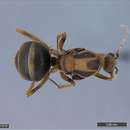en
names in breadcrumbs


Arnold, 1922, Ann. South. Afr'. Mus., p. 579.
[[ worker ]]. Polymorphes, [[ male ]]. Aussi grand que la 9. Metanotum plus ou moins distinct chez les [[ worker ]] major. Antennes comme chez le s. - g. Anoplolepis . Ocelles chez la [[ worker ]] major, manque chez [[ worker ]] minor.
1925. Cat. Gen. Insect. Formicinae , p. 18.
[[ worker ]] Monomorphes. " Taille mediocre. Yeux en avant du milieu des cotes de la tete. 2 e article du funicule bien plus court que le suivant. Ecaille fortement inclinee en avant.
Emery, 1925, Cat. Gen. Insect. Formicinae , p. 16.
[[ worker ]]. Monomorphes; assez grandes. Les 4 premiers articles du funicule subegaux, le 3 e plutot plus long que le premier. Ocelles absents.
[[ male ]]. Beaucoup plus petits que les [[ queen ]].
Mesonotum non etrangle ni imprime en avant des stigmates qui sont bas. Epinotum plus ou moins releve. Especes generalement grandes.
Type du sous-genre: P. longipes Jerd.
Anoplolepis, also known as the "pugnacious ants", is a genus of ants in the subfamily Formicinae and tribe Lasiini.[2] The genus is mainly found in the Afrotropics, with a few native species known from the Malagasy and Oriental regions (and some introduced in other places).[3]
Anoplolepis, also known as the "pugnacious ants", is a genus of ants in the subfamily Formicinae and tribe Lasiini. The genus is mainly found in the Afrotropics, with a few native species known from the Malagasy and Oriental regions (and some introduced in other places).
 A pugnacious ant (Anoplolepis) captured in India
A pugnacious ant (Anoplolepis) captured in India